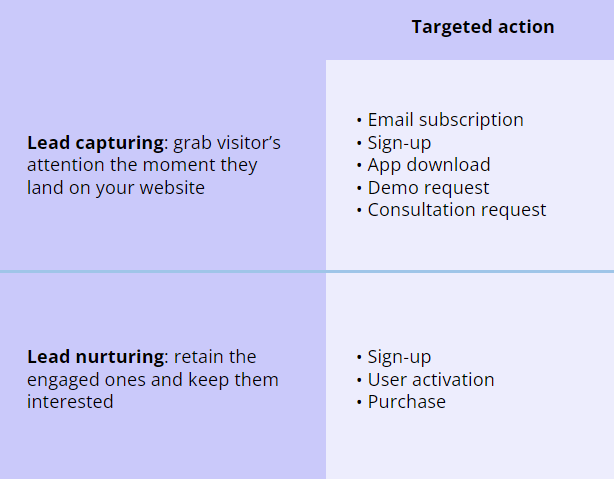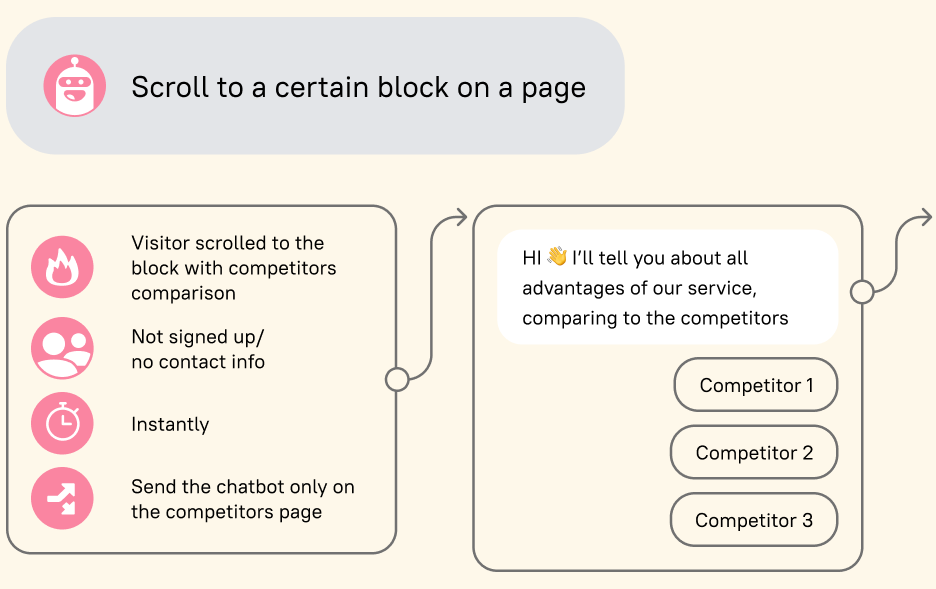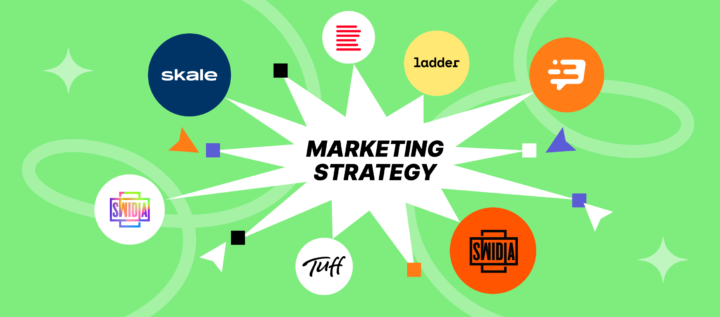What is Growth Marketing? Unlock Your Business Potential

Imagine walking into a room with opportunities, strategies, and innovative ideas to help your business skyrocket. Welcome to the exciting world of growth marketing! If you’ve been wondering how to unleash your product true potential and maximize its success, you’ve come to the right place.
Today, more than a traditional marketing approach is needed to keep your business ahead of the game. That’s where growth marketing comes in. But what exactly is it, what does growth marketing do, and how can you harness its power to transform your business?
In this article, you’ll learn growth marketing meaning explained by experts, how it works, and its real-life growth marketing examples to help you start transforming your company. Get ready to revolutionize your marketing approach via experiments!
Test growth hypotheses quickly and without developers with Dashly

Growth marketing definition
You know how gardeners meticulously plant seeds, water them, and watch them grow into thriving plants? Growth marketing is like that, but for businesses!
So let’s learn what exactly does growth marketing do?
It’s all about nurturing the entire customers journey, from the moment people discover your product to the point where they can’t help but tell their friends about it.
Imagine your growth marketing team as mad scientists, combining their creative juices with analytical prowess to cook up experiments that drive users engagement, sales, leads, email conversion, etc. They’re always looking for ideas to optimize and boost business growth, like finding the secret ingredient that makes a dish irresistible.
Growth marketing is like a game of “Where’s Waldo?” for key performance indicators (KPIs), such as customer acquisition cost and other growth marketing metrics. Growth marketers are focused on scanning the landscape to spot these elusive KPI results. And once they find them, they’ll build a growth plan making them even better!
Here is how experts define growth marketing:
“Growth marketing is the art of fueling business success by combining data, experimentation, and creativity across the entire customers journey, forging deep connections with the audience and staying ahead in an ever-changing market.” — Polly, growth marketing expert at Dashly
Sean Ellis, who first coined the term, defines growth marketing as “an integrated approach to growing a business by optimizing the entire customer journey, from acquisition to retention, using data and experimentation.
Neil Patel expands on this, focusing on the entire funnel, leveraging data to make informed decisions, and prioritizing long-term growth over short-term gains.
What are growth marketing benefits?
Oh, what wonders growth marketing does to business! Let me tell you some fantastic benefits it can bring to your product growth, backed by some juicy statistics.
- You get more bang for your buck. Growth marketing helps you maximize your marketing efforts, attracting more users without breaking the bank. Businesses that excel at growth marketing can lower their customer acquisition cost (CAC) by as much as 50%.
- Then, there’s the magic of customer retention. With hacking growth, you don’t just get users to walk through the door; you make them feel right at home and keep them coming back for more. Studies show that increasing customer retention rates by just 5% can boost profits by 25% to 95%.
And guess what? Happy customers love to chat! Growth marketing can turn your site visitors into enthusiastic advocates, spreading the word about your fantastic product. Word of mouth generates more than twice the sales of paid advertising!
Thanks! Here’s your list of must-read books on growth hacking

- It’s also like having a crystal ball. By analyzing data and tracking KPIs, growth marketing helps you make informed decisions and avoid costly mistakes. Companies using data-driven B2C and B2B growth marketing strategies are six times more likely to be profitable year-over-year.
- Oh, and let’s not forget about personalization. Growth marketing is all about understanding your users and tailoring your strategies to meet their unique needs. After all, who doesn’t love feeling special? Personalized growth marketing can lead to an average sales uplift of 19%.
- Lastly, growth marketing keeps you on your toes. By constantly experimenting and adapting, you stay ahead of the competition and make sure your business keeps growing and thriving. Companies that adopt a growth mindset are 3.8 times more likely to achieve above-average growth.
So, there you have it! Growth marketing is like a secret weapon that helps your product flourish, delight users and stay ahead of the game.
Read also:
But how it is different from traditional marketing?
Growth marketing vs. traditional marketing
Traditional marketing often falls short in the race for business success, as it focuses narrowly on customer acquisition, overlooking the power of retention and loyalty. Growth marketing, on the other hand, embraces the entire customers journey, leveraging data and experimentation to drive sustainable, long-term growth — sustainable being the winning edge.
Traditional marketing prioritizes customer acquisition, often overlooking the importance of retention and product or company loyalty. In contrast, growth marketing embraces a holistic approach, optimizing every touchpoint with your audience, from attracting prospects to delighting loyal customers. All these points are essential for growth marketing canvas.
Table of difference
| Traditional marketing | Growth marketing | |
| Focus | Specific channels and tactics, like SEO, PPC, or social media, to drive customer acquisition and company awareness. | Entire customer journey, from acquisition and activation to retention and referral, to drive sustainable long-term growth. |
| Goals | Short-term goals, like increasing sales or customer loyalty for a specific campaign. | Long-term success by continuously improving the customer experience and fostering loyalty leads to more referrals and repeat business. |
| Experiments | Generally lacks the same level of iterative experimentation and data-driven optimization. | Continuous testing, learning, and optimization to improve performance across the entire customer lifecycle. |
The secret ingredient? A relentless commitment to experimentation and data-driven decisions sets growth marketing apart from its traditional counterpart. This comprehensive marketing growth strategy is what your business needs to stand out in today’s competitive landscape.
Stay tuned as we delve further into growth marketing, unveiling why it’s the game-changer your team has been waiting for.
Read also:
Who are growth marketers?
Thinking about growth marketer definition picture a creative, data-driven individual who thrives on innovation and isn’t afraid to experiment. If you want to find growth marketers for your startup, look for experts at navigating the entire customers journey, from acquisition to retention and everything in between.
Here is what Brian Balfour, a growth marketing expert, says about what is a growth marketer: “someone curious, empathetic, and analytical, with a strong understanding of the customer, the product, and the channels through which the product is marketed.”
Sean Ellis, who is credited with coining the term “growth hacking,” provides the next growth marketers definition:
“Growth hackers are a hybrid of marketer and coder, one who looks at the traditional question of ‘How do I get customers for my product? ’ and answers with A/B tests, landing pages, viral factor, email deliverability, and Open Graph.”
Get +10% to conversion to a target action with free growth tips from Dashly experts
We’ll assess your website, find growth points, and suggest hypothesis ideas tailored for your business.

So, what does a growth marketer do?
They wear many hats, diving into data analysis, running experiments, crafting compelling content, and optimizing marketing channels. No journey is complete without failures, though.
Want more details? Here is how Dashly’s growth marketers share their experience on how they achieved the platform’s trial-to-paid conversion growth by an impressive 25%. Admittedly, their path to success wasn’t smooth; however — 36 hypotheses were tested, and 27 didn’t work out. Nevertheless, the process brought lots of valuable insights and, in the end, helped to build an efficient team skilled at the growth marketing test process.
It’s good to remember that the ultimate goal is to fuel product growth by constantly refining the customers journey and discovering new opportunities for success.
Famous growth marketers to learn from

Sean Ellis
As the person who coined the term “growth hacking,” Sean Ellis is a pioneer in the growth marketing field. He has helped companies like Dropbox, LogMeIn, and Eventbrite achieve rapid growth.

Andrew Chen
A well-known growth marketer and investor, has worked with companies like Uber, AngelList, and Tinder. His blog covers a wide range of growth marketing topics and strategies.

Neil Patel
A successful entrepreneur and digital marketer, Neil Patel co-founded Crazy Egg, Hello Bar, and KISSmetrics. His blog and podcast offer valuable insights on growth marketing, SEO, and content marketing.

Brian Balfour
As the former VP of Growth at HubSpot (one of the best growth marketing tools, btw), Brian Balfour is a growth marketing expert with extensive experience. He is the founder of Reforge, an online platform offering growth marketing courses for professionals.

Hiten Shah
Co-founder of KISSmetrics, Crazy Egg, and FYI, Hiten Shah is a seasoned entrepreneur with a wealth of experience in growth marketing. He shares valuable insights through his blog, podcast, and speaking engagements.
These growth marketers are influential thought leaders in the industry, and learning from their experiences, writings, and talks can help you gain valuable growth marketing tips.
5 components of growth hacking strategy
1. Audience Targeting
The first step is identifying your target audience and their characteristics like behaviors, interests, and demographics. Knowing your audience is important to create effective campaigns that resonate with them.
2. Funnel Optimization
This component is essential to engage users and convert them into customers. Optimizing the funnel involves using effective call-to-actions, landing pages, email campaigns, and lead magnets to encourage users to take specific actions that lead to great conversion.
3. Acquisition Channels
Growth experts practice different acquisition channels like paid advertising, social media marketing, email marketing, content marketing, and others. Choosing the right channel depends on your target audience and your campaign objectives, and utilizing cross-channel marketing can maximize reach and impact.
4. A/B Testing
Experimentation is essential to fine-tune and optimize your growth marketing campaign’s messaging, targeting, and creative approach. A/B testing can help to test and measure different elements of your campaign and determine which approach works best.
5. Conversion growth analytics and reporting
This component involves tracking and analyzing your growth campaign’s progress by monitoring key metrics like conversion rates, customer retention, and ROI. Data-driven analysis and reporting help identify areas for improvement, make data-driven decisions, and adjust the campaign to achieve successful growth.
Thanks! Here’s your copy of the growth strategy template

Types of successful growth marketing campaigns
Here are five types of growth marketing campaigns and their explanations:
Referral Campaigns
These campaigns aim to generate referrals by incentivizing existing customers or influencers to refer others to your product or service. Incentives may include discounts, rewards, or exclusive access to products or blog content.
Viral Campaigns
These campaigns aim to achieve broad organic reach and high engagement levels by creating shareable blog content that resonates with the target audience. Viral growth campaigns can take many forms, including videos, memes, or challenges.
Influencer growth campaigns
These campaigns involve working with influencers or industry leaders who have a large and engaged following to promote your product or service. Influencer marketing can help increase company or product awareness and credibility by leveraging the influencer’s existing audience.
Email Campaigns
Email marketing campaigns aim to convert leads into customers or nurture existing customers. Email campaigns may include promotions, weekly newsletters or educational content to engage and retain the customers.
Social Media Campaigns
These growth marketing campaigns leverage social media channels like Facebook, Twitter, Instagram, LinkedIn, and others to reach and engage with the target audience. Social media campaigns can take many forms, including paid advertising, organic posts, contests, and interactive content like quizzes or polls. A well-crafted social media strategy can help build product or company awareness, generate traffic, users, and foster customer engagement.
Overall, growth marketing campaigns aim to maximize ROI and drive long-term growth through creative and data-driven campaigns across multiple channels. Choosing the right type of campaign depends on various factors like the target audience, campaign goals, and budget.
To summarise: how to start growth marketing within your company
Now you know what growth marketing is. But starting it can feel overwhelming, so here’s a short guide to help you take the first steps:
- Set clear, SMART objectives.
- Identify your target audience and create buyer personas.
- Choose the right growth marketing channels.
- Develop a data-driven growth marketing plan.
- Run experiments, track performance, and optimize based on results.
- Scale successful strategies and foster a growth mindset.
- Network and learn from experts to gather new SaaS growth hacks and stay current.
Remember, growth marketing is an iterative process; continuously learn, adapt, and optimize your efforts for sustainable business growth.
Btw, if you need inspo for your experiments, check out our growth marketing playbook with over 40 ideas from Dashly and our customers.
Get +10% to conversion to a target action with free growth tips from Dashly experts
We’ll assess your website, find growth points, and suggest hypothesis ideas tailored for your business.

FAQ on growth marketing
What does growth marketing mean?
The answer to “Growth marketing what is it?” is simple. In short, growth marketing is a strategy that helps enhance businesses by focusing on every stage of the customers journey and using data and experimentation to optimize and innovate their marketing efforts.
What is a growth marketing channel?
A growth marketing channel is a method or platform businesses use to reach and engage with their target audience, intending to drive sustainable growth and success.
What is organic growth in marketing?
Organic growth in marketing is when a business grows through natural means, such as word-of-mouth referrals, search engine optimization, and social media engagement. Unlike paid marketing, this traffic approach focuses on building genuine connections with your audience and providing value to them, which can result in long-term, sustainable growth for your business.
What is growth marketer?
Growth marketers are a hybrid of marketer and coder, looking at the traditional question of ‘How do I get customers for my product? ’ and answering with A/B tests, landing pages, viral factor, email deliverability, and Open Graph.
What do growth marketers do?
They analyze data, come up with a growth hypothesis, run experiments, and collaborate with cross-functional teams to optimize every touchpoint in the customer journey, from acquisition to retention.
What is growth marketing vs performance marketing?
While performance marketing focuses on specific campaigns and tangible results like clicks, conversions, and leads, growth marketing takes a broader, more holistic approach to drive long-term business success.
What is growth in marketing?
Growth in marketing is increasing a business’s customer base, revenue, and market share using creative strategies and data-driven tactics. Examples include optimizing the customer journey, personalizing marketing campaigns, and conducting A/B testing to achieve campaign conversion growth.
What are growth marketing campaign KPIs?
Suppose a company conducts A/B testing on its website’s landing page, comparing two different call-to-action buttons. After analyzing the results, they found that one version leads to a 15% increase in conversions compared to the other. This indicates growth in marketing performance, as the company has successfully optimized its landing page to achieve a higher conversion rate.
Read more about marketing growth metrics.
What are basic growth marketing terms?
Here are some basic growth marketing terms to help you get started:
- A/B Testing: A method of experimentation where two versions of a marketing element, such as a landing page or email, are tested against each other to determine which performs better.
- Conversion Rate Optimization (CRO): Improving the effectiveness of a website or marketing campaign to increase the percentage of visitors who take a desired action, such as purchasing or filling out a form.
- Key Performance Indicators (KPIs): Metrics used to measure the success of a marketing campaign or strategy.
- Funnel: A visual representation of the customer journey, from the initial awareness stage to the final conversion.
- Retention Rate: The percentage of customers who continue using a product or service over a period.
- User Persona: A fictional representation of a target customer, including demographic information, behavior patterns, and pain points.
- RevOps tech stack: Guide to the best tools
- Revenue operations metrics: 10 metrics and KPIs to track your performance
- Product led growth metrics: 13 key indicators for SaaS companies to track
- PLG tools: Ultimate guide to the best instruments
- Benefits of Product led growth: 12 PLG benefits for your business
- Sales led growth: What is it and why your business needs it
- Growth marketing case studies: 12 stories with detailed tactics and numbers achieved
- RevOps best practices: 13 tactics to implement this year







![25 growth hacking books [recommended by Dashly growth hackers]](https://www.dashly.io/blog/wp-content/uploads/2023/05/Growth-Hacking-Books-720x317.png)



